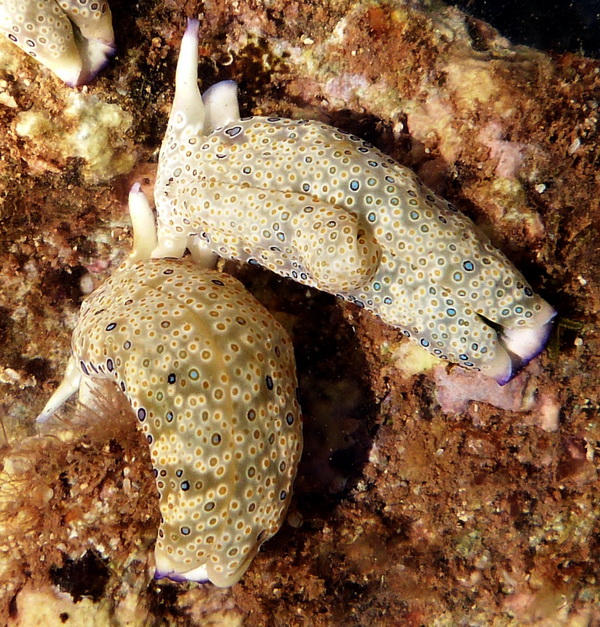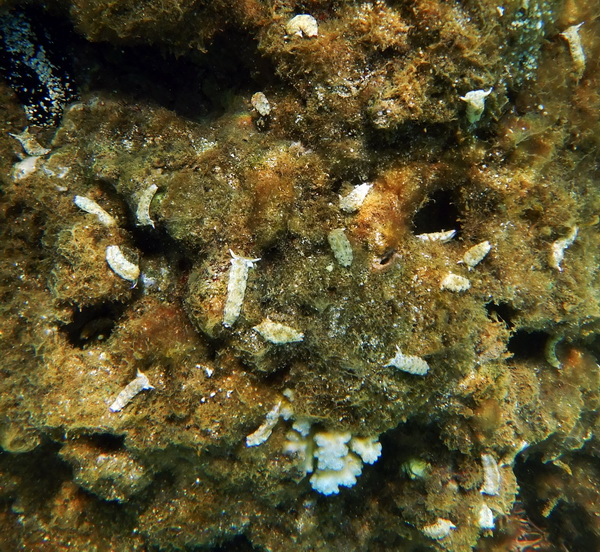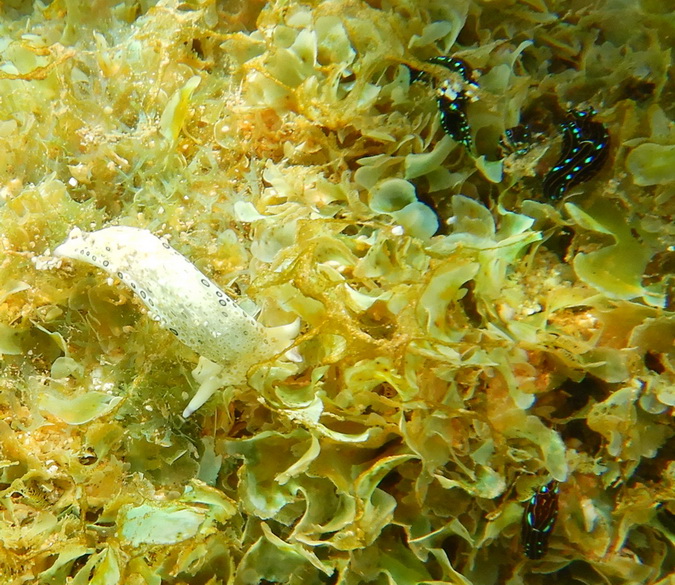July 16, 2020

Ringed sap suckers, North Shore Oahu. ©Susan Scott
I usually snorkel with my camera, because if I see a species I don’t know, or an animal doing something eye-catching, I can snap a photo for later reference. Occasionally, however, my Nikon Coolpix records something I didn’t notice at all. Then later, a surprise shows up on the download.
That happened last week while I was editing some pictures I took of one of my favorite invertebrates, the ringed sap sucker.
This summer, these little vegetarians, about 2 inches long, have been widespread, hugging rocks, inching along rubble, and grazing in clumps of seaweed throughout my usual snorkeling range.

©Susan Scott
Relatives of nudibranchs (pronounced NOO-dee-branks), sap suckers use their single sharp tooth to pierce a plant cell, and suck out the contents. The sap sucker digests the seaweed’s nutrients, but recycles its chloroplasts, the bodies in each plant cell that make sugars from sunlight and carbon dioxide (AKA photosynthesis.)
By storing the green chloroplasts under flaps on its back, where sunlight bathes the chloroplasts, the sap sucker carries its own veggie garden. When seaweeds are scarce, sap suckers can live for months without grazing.

The sap sucker’s stored chloroplasts. My finger is holding open the back flaps for the photo. ©Susan Scott
Sap sucker is a nickname (scientific name, Sacoglossa) for this animal, but it has another good one too: solar-powered slugs.
As I edited my recent shots of the ringed sap suckers, so-named after the pretty purple rings on their tan bodies, I saw that my camera had captured another critter. Several individuals of a sea-slug-type species I hadn’t noticed showed up in the upper right corner of the picture.
The inch-long black creatures with bright blue spots and orange lines are one of several native headshield slugs. This particular species is named Chelidonura alisonae after the late malacologist, author, and UH professor, Alison Kay.

A grazing ringed sap sucker, left. Headshield slugs (black with bright blue spots), upper and lower right. ©Susan Scott
The headshield name comes from the animal’s broad head, handy for plowing beneath the sand in search of prey. Two long flaps fold over the back of the headshield slug’s body, one longer than the other, trailing behind like a tail.
The term slug is an unappealing name for these exquisite creatures, and someone else agreed. The animals’ family name is Aglajidae, agla meaning splendid or brilliant in Greek.
So concentrated was I on watching the sap sucker suck sap, that I missed seeing the nearby headshield slugs. But my camera saw them, and the gift it delivered from its SD card made my day. I now know where to look for headshield slugs on future swims.
I don’t often forget my camera when snorkeling, but it happens. Next time I’m definitely going back for it.
For a better picture of my camera’s headshield slugs, check out bit.ly/3j20tiU